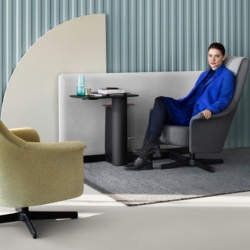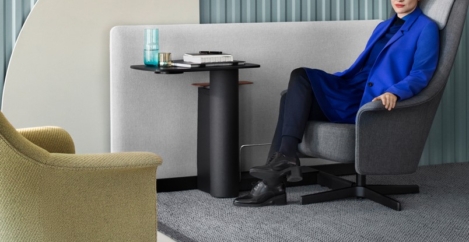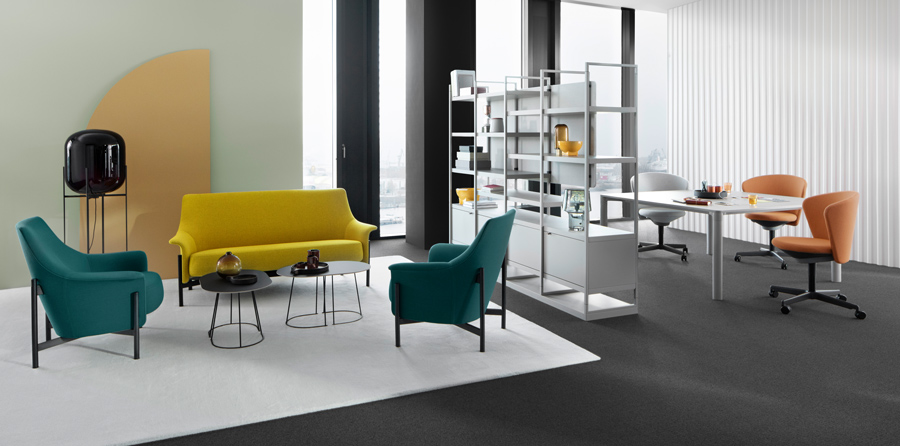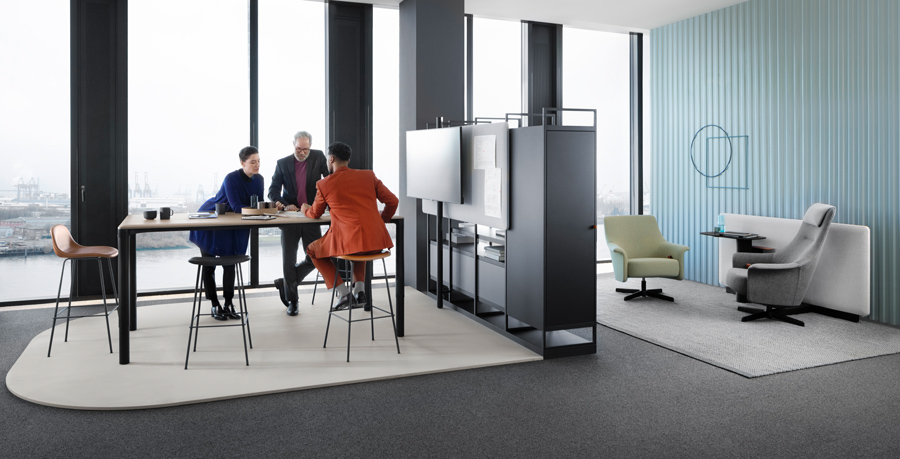July 27, 2020
Bene launches Pearson Lloyd designed PORTS system
 Created by the well-known London design studio PearsonLloyd, and a pre-launch winner of the “Red Dot Design Award: best of Best” and the “iF Gold Awaard 2020”: Bene has launched a revolutionary office concept in the form of a completely new design line – PORTS. The world is changing and we are changing with it. Stability, flexibility and agility are the key success factors for dynamic organisations. PORTS embodies this new reality in interior design and furnishings, creating multifunctional spaces that allow for many different styles of working and that are flexibly adaptable. PORTS is both a design line and an office concept, bringing people, ideas and functions together – to lead together.
Created by the well-known London design studio PearsonLloyd, and a pre-launch winner of the “Red Dot Design Award: best of Best” and the “iF Gold Awaard 2020”: Bene has launched a revolutionary office concept in the form of a completely new design line – PORTS. The world is changing and we are changing with it. Stability, flexibility and agility are the key success factors for dynamic organisations. PORTS embodies this new reality in interior design and furnishings, creating multifunctional spaces that allow for many different styles of working and that are flexibly adaptable. PORTS is both a design line and an office concept, bringing people, ideas and functions together – to lead together.
PORTS was created by the internationally renowned London design studio PearsonLloyd, who designed the business class cabins for Lufthansa and the WorkLife rooms for the Intercontinental Hotel Group – and also Bene’s iconic PARCS furniture range. In 2009, Bene’s PARCS introduced a completely new kind of collaboration zone for modern offices. With the launch of PORTS, the ten-year success story of collaboration between the office expert and PearsonLloyd continues: even before its official launch, PORTS had won the “Red Dot Design Award: Best of Best”, and the “iF Gold Award 2020”.
Lead together
“Back in 2009 Bene provided fresh inspiration with its PARCS design line, creating a revolutionary new communication zone in the office. PORTS demonstrates our continuing commitment to innovation. PORTS promises inspiring collaborative work and productive interaction. Three product lines – TABLE, LOUNGE and STORAGE – complement each other, reflecting the high expectations of contemporary leadership. They can be combined for optimal adaptability to the needs of individuals in a modern working environment. That is what we mean by ‘lead together’,” explains Michael Fried, Executive Board Member for Sales, Marketing and Innovation at Bene.
New leadership environment
Everything is changing: systems are being reorganised, established processes are being questioned, and new management styles are being introduced. To meet these challenges together, and to make the most of the opportunities they offer, organisations need to collaborate and communicate better than ever. Organisations need to accept new kinds of management and rituals, and even to encourage them. As well as encounter zones, they must also provide places for retreat – to facilitate both lively interaction and quiet focus. They need multifunctional spaces that reflect the different ways people work, that grow with the organisation’s needs and that are flexibly adaptable. Effective company management today needs more openness and less formality. Both in office spaces and in the way people think. Flexibility, multifunctionality and options for privacy and quiet work are more important than ever.
The PORTS design line
PORTS is a multifunctional hub, like a modern high-performance port. Office zones that were once separate are merged together into a multifunctional space that facilitates collaboration while also supporting focussed individual work. Private workspaces function as places of retreat or individual workstations, while the table is a focal point for teams, where ideas are exchanged and generated. Semi-transparent room dividers provide structure, with functional applications for individuals and for groups. The three modules – PORTS LOUNGE, TABLE and STORAGE – can be combined in various different ways to meet the most diverse requirements.
PORTS LOUNGE
A relaxing lounge area is an essential part of the contemporary office environment. The Sofa and Lounge chairs can be combined to form comfortable seating areas. The Panel, Revolving Table and PORTS Active Chair together make up the PORTS Task Lounge. The Lounge Chair has a unique seat tilt mechanism allowing smooth transition from a relaxed, passive posture to a more upright, active position. The key to this range’s versatility is the movable table module and the multifunctional Lounge Chair. Ideal for today’s times when mobile devices have liberated us from static positions behind a desk.
The PORTS Task Lounge can be configured as a “meeting lounge”, encouraging encounters and interactions, free from conference tables and formal distances. Several modules can be combined to define a new kind of meeting space.
PORTS TABLE
Innovation, design and functionality are the key features of the PORTS Table, transforming a simple table into much more than just a classic work surface. It can be converted in a flash from the traditional executive table into a desk, as a focal point for interaction and communication: the four-leg base of this elegant table conceals a modern, electronic height adjustment mechanism, which transforms a workstation rapidly and almost completely silently into the central point of an informal meeting. The PORTS Power Tray provides easy access to power and network connections.
PORTS STORAGE
Workstations and meeting rooms are merged into a single coordinated concept – this needs room dividers to provide structure in the office. PORTS Storage can be used as a room divider and provides practical options both for individuals and for shared use. Open and private areas are defined by semi-transparent dividers that can be used in many different ways: PORTS Storage can serve as a private cloakroom with shelves, a mirror, and refrigerator for individuals, or can be used functionally with an optionally integrated pinboard, shelf, whiteboard or a screen for teams.
“The market for executive offices and furniture is still defined in terms of hierarchy and old concepts of status, without considering the users’ needs; the market has not changed for over a century. PORTS offers a new way to define what a private workspace looks like and how it functions,” says Tom Lloyd. “The private office is slowly disappearing. And managers are becoming more open, collaborative, democratic – and younger. So they need as much time and space as possible to plan how they will fulfil their responsibilities and to think creatively,” adds Luke Pearson.
















